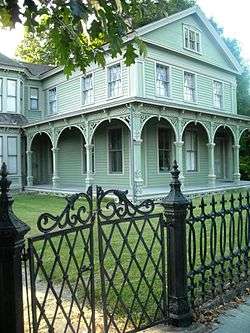Rossie Velvet Mill Historic District
The Rossie Velvet Mill Historic District is located in the Mystic village of Stonington, Connecticut. Its main focus is the former Rossie Velvet Mill, a large brick industrial facility on the east side of Greenmanville Avenue that is now a research center for the nearby Mystic Seaport Museum. The district extends along Greenmanville Avenue between Pleasant Street in the north and the museum complex in the south. Most of the buildings in the district are residential housing built to house workers at the mill, and were built between about 1850 and 1950. The district includes 51 properties in 120 acres (49 ha).[2] The district was listed on the National Register of Historic Places on March 9, 2007.[1]
Rossie Velvet Mill Historic District | |
 | |
  | |
| Location | Roughly along Bruggerman Court, Bruggerman Place, Greenmanville Avenue, Hinckly Street, Pleasant Street, Rossie Street, Velvet Street, Stonington, Connecticut |
|---|---|
| Coordinates | 41°21′13″N 71°57′46″W |
| Area | 120 acres (49 ha) |
| Architect | Favretti, Giovanni; et al. |
| Architectural style | Colonial Revival, Bungalow/Craftsman |
| NRHP reference No. | 07000110[1] |
| Added to NRHP | March 9, 2007 |
The area that houses the Rossie Velvet Mill was basically agricultural until about 1850, it farmers providing goods to the shipbuilders and other businesses in Mystic. A small textile mill began operation on the bank of the Mystic River in that year, on what are now the grounds of the museum, and that area developed as a modestly scaled industrial area. The Rossie Velvet Mill was established here in 1897, spurred on by two factors: first, a local business development group recruited velvet makers from Germany to the area, repeating a success in Stonington village, and the McKinley Tariff of 1890 encouraged the owners of a velvet mill in Süchteln (northwestern Germany) to open a manufacturing facility in the United States to avoid the tariff. This business was a major local success, employing 200 workers (including a significant number of experienced German immigrant weavers) at what was the village's largest employer. The Rossie operation failed in the Great Depression, but the plant was soon operating under different ownership. It was permanently closed in 1958.[2]
References
- "National Register Information System". National Register of Historic Places. National Park Service. March 13, 2009.
- "NRHP nomination for Rossie Velvet Mill Historic District". National Park Service. Retrieved 2015-01-31.
| Wikimedia Commons has media related to Rossie Velvet Mill Historic District. |